小学六年级英语语法祈使句
六年级上册英语语法课件祈使句牛津上海版(一起)(共14张PPT)

What she can do?
The room is in a mass, what should the students do?
3.______ me the truth, or I am not going to leave the room.
A. Telling B. to tell C. if you don’t tell D. √ Tell
祈使句的含义
祈使句,无主语 动词原形作谓语 客气加上please
祈使句四大天王
A. √ Keep B. To keep C. Keeping
2.__________ buy your ticket from a ticket machine. There are lots of people there. A. Not B. not too C. Don’t D. Don’t to √
例如:
Look after the twins today.
我是B 天王: Be + 表语(名词、形容词等)+ 其它成分。
例如: Be a good student!做个好学生!
我是L天王 : Let + 宾语(通常是第一、第三人称宾格)+ 动词原形 +其它成分。
例如: Let’s go home! 咱们回家吧!
祈使句
Stop
Dont touch me
Come play with me
祈使句有什么 要注意的吗?
祈使无主语,you常被 省去
动原当谓语, 否定加 don’t ; 朗读用降调, 惊叹和句号。
我是肯定式祈使句。我直接用动词(包括及物动词和不及 物动词)原形作为句子的开头。 例如:Be careful next time. 下次细心点。
英语六年级上册第二单元句式
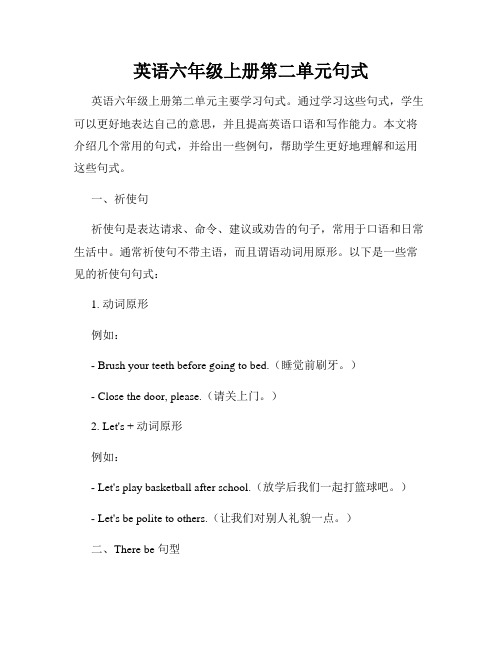
英语六年级上册第二单元句式英语六年级上册第二单元主要学习句式。
通过学习这些句式,学生可以更好地表达自己的意思,并且提高英语口语和写作能力。
本文将介绍几个常用的句式,并给出一些例句,帮助学生更好地理解和运用这些句式。
一、祈使句祈使句是表达请求、命令、建议或劝告的句子,常用于口语和日常生活中。
通常祈使句不带主语,而且谓语动词用原形。
以下是一些常见的祈使句句式:1. 动词原形例如:- Brush your teeth before going to bed.(睡觉前刷牙。
)- Close the door, please.(请关上门。
)2. Let's + 动词原形例如:- Let's play basketball after school.(放学后我们一起打篮球吧。
)- Let's be polite to others.(让我们对别人礼貌一点。
)二、There be 句型There be 句型用来指出某地或某个区域存在某物或某人。
其中主语是 there,谓语是 be 动词的不同形式,后面跟着宾语。
以下是一些常见的 There be 句式:1. There is + 单数名词例如:- There is a book on the desk.(桌上有一本书。
)- There is a cat under the table.(桌子底下有一只猫。
)2. There are + 复数名词例如:- There are some flowers in the garden.(花园里有一些花。
)- There are many books in the library.(图书馆里有许多书。
)三、陈述句变疑问句陈述句变疑问句是通过改变陈述句的语序或者增加助动词来构成问句。
以下是一些常见的陈述句变疑问句的句式:1. 一般疑问句:陈述句中的动词提到句首,句末加问号。
例如:- You are a student.(你是一个学生。
六年级语法专题:祈使句课件(共30张PPT)

e.g.Go and wash your hands. 去洗你的手。-命令 Be quiet, please. (Please be quiet.) 请安静。-请求 Be kind to our sister.对妹妹要和善。-劝告 Watch your steps. 走路小心。-警告 Look out! Danger! J心! 危险!一强烈警告 Keep off the grass. 勿践草坪。-禁止 No parking. 禁止停车。-禁止
let’s make a summary
Thanks for your attention!
(√ ) ( ×)
3. Let's go hiking. 4. What a lovely girl!
( √) ( ×)
5. Wash your hands before meals.
( √)
例题精讲Biblioteka 1. No ________ ! A. eat B. eating C. eatting 答案: B、 分析:点拨:固定用法。表达禁止做某事:No+动词的ing形式。
2. Be+名词短语或形容词+其他成分。如: Be a good boy!做个好孩子! Be careful!小心! 3. Let+宾语+动词原形+其他成分。如: Let me help you. 让我来帮你。 Let's clean our classroom. 让我们打扫教室。 【注】有时为了加强语气,可在动词之前加do。如: Do be careful!务必小心! Do let Mary water the flowers. 务必让玛丽浇花。
___D__o_n_'_t_d_r_i_v_e_t_o_o__f_a_s_t_. __________________
祈使句语法(细致整理)

祈使句讲解一、祈使句:用于表达命令、请求、劝告、警告、禁止等的句子叫做祈使句. 祈使句的作用是要求、请求或命令、劝告、建议别人做或不做一件事。
祈使句的句末一般用感叹号,但是有些祈使句的语气较弱,可以用句号结尾祈使句因对象(即主语)是第二人称,所以通常都省略。
祈使句的动词都为一般现在时,例:Go and wash your hands.例如:保持肃静!Be kind to our sister. Watch your steps. 表示禁止的句式有:不准、不要、别、No parking.二、表现形式●肯定结构:1. Do型(即:动词原形(+宾语)+其它成分)。
如:Please have a seat here.有的祈使句在意思明确的情况下,动词可省略。
如:This way, please. = Go this way, please. 。
2. Be型(即:Be + 表语(名词或形容词)+其它成分)。
如:Be a good boy! 要做一个好孩子!3. Let型(即:Let + 宾语+ 动词原形+ 其它成分)。
如:Let me help you. 让我来帮你。
●否定结构:1.Do型和Be型的否定式都是在句首加don\'t构成,如:Don\'t forget me!Don\'t be late for school!2.Let型的否定式有两种:“Don\'t + let + 宾语+ 动词原形+ 其它成分”和“Let + 宾语+ not + 动词原形+ 其它成分”。
如:Don\'t let him go. / Let him not go. 别让他走。
3.有些可用no开头,用来表示禁止性的祈使句。
如:No smoking! No fishing! 禁止钓鱼!三、祁使句类型祁使句是用来向别人提出命令,建议或请求的句式.常见的祁使句有以下五种:1) Let's 开头的祁使句如: Let's say it in English .2) 动词原形开头的祁使句. 如: Listen to the teacher .3) Shall I 开头的祁使句 . 如: Shall I carry the parcel for you ?4) Will you 开头的祁使句. 如: Will you come here early ?5) 以Please 开头的祁使句如: Please take a message for him.6)带呼语的祈使句,如:Mary, come down here ! (对mary 讲话,而不带呼语的且以动词原形开头的祈使句则对第二人称讲话)7)不让对方做某事, 英语用" Don't " . 例如:Don't speak loud . 不要大声讲话. Don't write in that way . 不要那样写."let"带头的祈使句是个常见的动词句型,它的主要用法有下列三种:1.表示“建议”。
六年级-祈使&感叹句-7-3
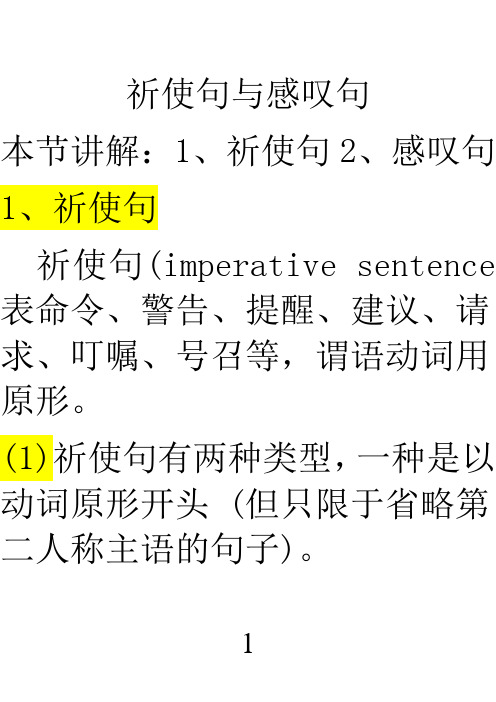
祈使句与感叹句本节讲解:1、祈使句2、感叹句1、祈使句祈使句(imperative sentence 表命令、警告、提醒、建议、请求、叮嘱、号召等,谓语动词用原形。
(1)祈使句有两种类型,一种是以动词原形开头 (但只限于省略第二人称主语的句子)。
11)祈使句的肯定式:动词(原形) + 其他如:Please give me a hand. (请帮忙) / Shut up! (住嘴!)Look out! There is a train coming.注意!火车来了!(提醒)Wear strong shoes as we shall do a lot of walking. 请穿结实的鞋子,因为我们要走许多的路。
(叮嘱)2At the beginning, collect as many stamps as you can. 开始时,尽可能多多地收集邮票。
(建议)Leave her where she is ! 让她留在原地!(命令)Give blood if you can and many lives will be saved.如果你能,来献血吧,这样会救很多人的命。
(号召)3肯定祈使句可用助动词do加强语气,常译为“务必、一定要”。
如:Do save me!天那!(救救我吧)Do come in.请进。
Do be careful when crossing the street.过马路时务必小心。
Do give my regards to your parents.请务必代我向你的父母问好。
Please do help me! (请千万帮4帮我。
)2)祈使句的否定式:Don’t +动词原形 + 其他祈使句的否定结构一般是在谓语动词前加do not或用don't(口语中),有时也可用never,若祈使句有主语,否定词用don’t或never要置于主语之前,不可用do not。
如:Please don’t talk in low voices. (请不要低声讲话。
pep英语六年级上册语法专题——祈使句和否定句
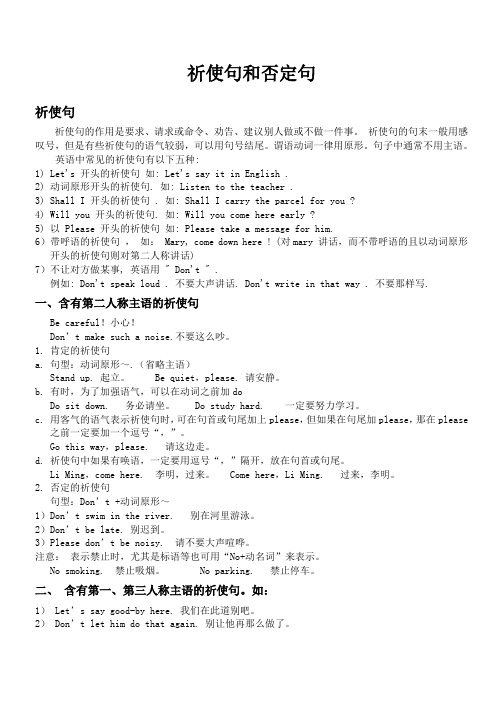
祈使句和否定句祈使句祈使句的作用是要求、请求或命令、劝告、建议别人做或不做一件事。
祈使句的句末一般用感叹号,但是有些祈使句的语气较弱,可以用句号结尾。
谓语动词一律用原形。
句子中通常不用主语。
英语中常见的祈使句有以下五种:1) Let's 开头的祈使句如: Let's say it in English .2) 动词原形开头的祈使句. 如: Listen to the teacher .3) Shall I 开头的祈使句 . 如: Shall I carry the parcel for you ?4) Will you 开头的祈使句. 如: Will you come here early ?5) 以 Please 开头的祈使句如: Please take a message for him.6)带呼语的祈使句,如: Mary, come down here ! (对mary 讲话,而不带呼语的且以动词原形开头的祈使句则对第二人称讲话)7)不让对方做某事, 英语用 " Don't " .例如: Don't speak loud . 不要大声讲话. Don't write in that way . 不要那样写.一、含有第二人称主语的祈使句Be careful!小心!Don’t make such a noise.不要这么吵。
1. 肯定的祈使句a. 句型:动词原形~.(省略主语)Stand up. 起立。
Be quiet,please. 请安静。
b. 有时,为了加强语气,可以在动词之前加doDo sit down. 务必请坐。
Do study hard. 一定要努力学习。
c. 用客气的语气表示祈使句时,可在句首或句尾加上please,但如果在句尾加please,那在please之前一定要加一个逗号“,”。
Go this way,please. 请这边走。
小学 祈使句
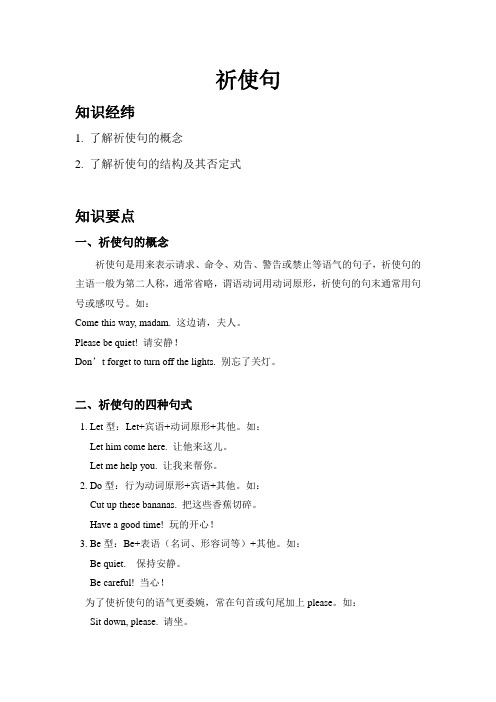
祈使句知识经纬1. 了解祈使句的概念2. 了解祈使句的结构及其否定式知识要点一、祈使句的概念祈使句是用来表示请求、命令、劝告、警告或禁止等语气的句子,祈使句的主语一般为第二人称,通常省略,谓语动词用动词原形,祈使句的句末通常用句号或感叹号。
如:Come this way, madam. 这边请,夫人。
Please be quiet! 请安静!Don’t forget to turn off the lights. 别忘了关灯。
二、祈使句的四种句式1. Let型:Let+宾语+动词原形+其他。
如:Let him come here. 让他来这儿。
Let me help you. 让我来帮你。
2. Do型:行为动词原形+宾语+其他。
如:Cut up these bananas. 把这些香蕉切碎。
Have a good time! 玩的开心!3. Be型:Be+表语(名词、形容词等)+其他。
如:Be quiet.保持安静。
Be careful! 当心!为了使祈使句的语气更委婉,常在句首或句尾加上please。
如:Sit down, please. 请坐。
Wait a minute, please. 请等一会儿。
4. No+v-ing / 名词。
如:No smoking! 禁止吸烟!No photos! 禁止拍照!三、祈使句的否定句1. Don’t+动词原形+其他。
如:Don’t talk loudly in the hallway. 不要在走廊里大声喧哗。
Don’t be late for school. 上课不要迟到。
2.以let开头的祈使句的否定形式有两种:①Don’t+let+宾语+动词原形+其他。
如:Don’t let the do g come into the room. 不要让狗到房间里来。
②Let+宾语+not+动词原形+其他。
如:Let’s not tell him it. It’s a secret. 我们别告诉他那件事,那是个秘密。
零基础语法:四种句子—祈使句知识点总结+练习(附解析)

四种句子:祈使句语法知识点详解一、祈使句定义祈使句表示请求、命令、建议等等。
谓语动词一律用原形。
句子中通常省略主语(you),句末用惊叹号或者句号,用降调。
二、肯定的祈使句(1)以系动词be开头的祈使句。
这种祈使句的常用结构:be+形容词/名词Be quiet/quick!安静些!/快点!Be a good student!做个好学生!(2)以实义动词开头的祈使句。
这种祈使句的常用结构为:动词原形+宾语(+其他)Come in, please!请进!Please open your books!请翻开书!有时,为了加强语气,可以在动词之前加doDo sit down.务必请坐。
Do study hard.一定要努力学习。
(3)let型(Let+宾语+动词原形+其他)Let him do it by himself.让他自己做。
Let me help you.让我帮助你。
Let’s go to the park.让我们去公园。
三、否定的祈使句(1)be型(Don’t be +其他成分(形容词、名词或介词短语))Don’t be careless!别粗心。
Never be late again next time!下次不要再迟到。
注意:①在这种句型中,be不能省略②否定副词not不可置于be之后(2)do型(Don’t +动词原形+其他)Don’t believe him!别相信他!Don’t worry!别担心!Never do it again!不要再这样做了!(3)Let引起的祈使句有两种否定形式①Let+宾语+not+动词原形+其他Let her not do that.别让她那样做。
Let’s not think about it. It’s only a waste of time.咱们别考虑了。
只是浪费时间。
②Don’t+ let+宾语+动词原形+其他Don’t let Jim do that.别让Jim那样做。
小学英语祈使句
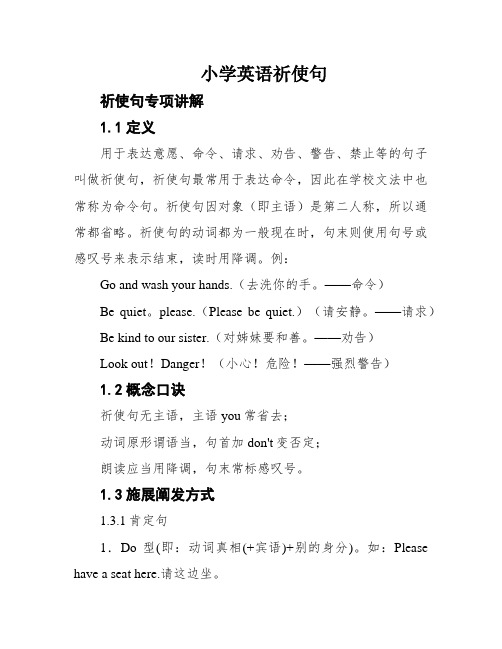
小学英语祈使句祈使句专项讲解1.1定义用于表达意愿、命令、请求、劝告、警告、禁止等的句子叫做祈使句,祈使句最常用于表达命令,因此在学校文法中也常称为命令句。
祈使句因对象(即主语)是第二人称,所以通常都省略。
祈使句的动词都为一般现在时,句末则使用句号或感叹号来表示结束,读时用降调。
例:Go and wash your hands.(去洗你的手。
——命令)Be quiet。
please.(Please be quiet.)(请安静。
——请求)Be kind to our sister.(对姊妹要和善。
——劝告)Look out!Danger!(小心!危险!——强烈警告)1.2概念口诀祈使句无主语,主语you常省去;动词原形谓语当,句首加don't变否定;朗读应当用降调,句末常标感叹号。
1.3施展阐发方式1.3.1肯定句1.Do型(即:动词真相(+宾语)+别的身分)。
如:Please have a seat here.请这边坐。
有的祈使句在乎思明白的情形下,动词可省略。
如:This way。
please。
= Go this way,please.请这边走。
2.Be型(即:Be +表语(名词或形容词)+其它成分)。
如:Be a good boy!要做一个好孩子!3.Let型(即:Let +宾语+动词原形+其它成分)。
如:Let me help you.让我来帮你。
1.3.2否定句1.Do型和Be型的否定式都是在句首加don't构成:如:Don't et me!不要忘记我!Don't be XXX!上学不要迟到!是系表布局——也就是没有行动动词可是有描述词的那种——利用Don't be有行动动词的就不克不及这么用,只能用Don't2.Let型的否定式有两种:“Don't + let +宾语+动词原形+其它成分”和“Let + 宾语+ not +动词原形+其它成分”。
小学英语知识点:祈使句
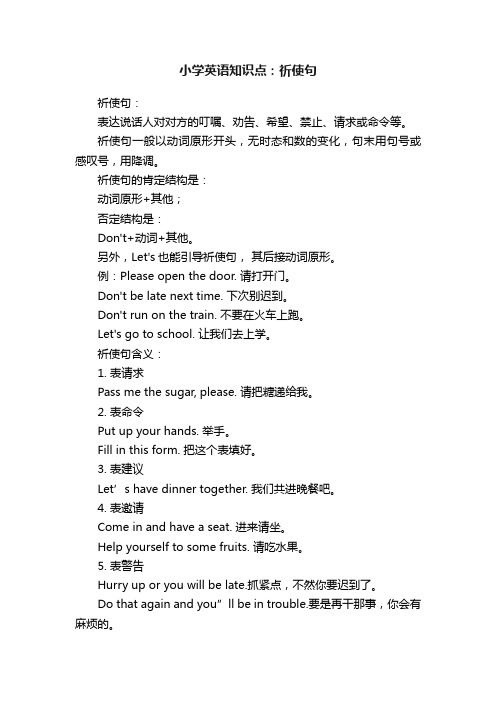
小学英语知识点:祈使句祈使句:表达说话人对对方的叮嘱、劝告、希望、禁止、请求或命令等。
祈使句一般以动词原形开头,无时态和数的变化,句末用句号或感叹号,用降调。
祈使句的肯定结构是:动词原形+其他;否定结构是:Don't+动词+其他。
另外,Let's也能引导祈使句,其后接动词原形。
例:Please open the door. 请打开门。
Don't be late next time. 下次别迟到。
Don't run on the train. 不要在火车上跑。
Let's go to school. 让我们去上学。
祈使句含义:1. 表请求Pass me the sugar, please. 请把糖递给我。
2. 表命令Put up your hands. 举手。
Fill in this form. 把这个表填好。
3. 表建议Let’s have dinner together. 我们共进晚餐吧。
4. 表邀请Come in and have a seat. 进来请坐。
Help yourself to some fruits. 请吃水果。
5. 表警告Hurry up or you will be late.抓紧点,不然你要迟到了。
Do that again and you”ll be in trouble.要是再干那事,你会有麻烦的。
6. 表禁止Don’t touch the exhibits.不要触摸展品。
Don’t play on the road.不要在马路上玩耍。
7. 表叮嘱Be sure to get there before nine. 务必在九点前赶到那里。
Take care not to catch cold. 小心别着凉了。
8. 表号召Workers of all countries, unite! 全世界工人阶级联合起来!9. 表祝愿Have a good trip. 祝你旅途愉快。
通用版英语六年级下册小升初语法祈使句课件

即学即练
1. _______ me the truth, or I'll be angry.
A. Telling B. To tell C. Told D. Tell
A. Turning left
B. Turn left
C. To turn left
D. Turns left
5. If the green light isn't on, ______ a minute.
A. wait
B. waits
C. will wait
D. waiting
Summary 1 V型祈使句 2 Be型祈使句 3 L型祈使句 4 No型祈使句 5 省略祈使句 6 其他祈使句
Be型的肯定结构:Be+表语
Be careful next time! Be quiet please! Be here tomorrow!
考点02:Be型祈使句 考点02:Be型祈使句
Be型的否定结构:Don’t +be +表语
Don’t be shy. Don’t be late again. Don’t be careless.
2. The TV is too loud. Please________.
A. turn it down B. to turn it down
C. turn down it D. to turn down it
3.______ more, and you'll improve your spoken English.
小学六年级英语语法祈使句

小学六年级英语语法祈使句,感叹句,疑问句[1]--------------------------------------------------------------------------------【网络综合- 小学六年级】一.祈使句Be careful!Please open your books.Let me have a try.Don’t open the door.口诀:祈使句无主语,主语you常省去,动词原形当谓语,句首加don’t变否定。
二.感叹句:用what 和how引导,what 修饰的是名词,how修饰的是副词或形容词。
结构:What + a/an + 形+可数名词单数+(主语+谓语)!What+形+可数名词复数/不可数名词+(主语+谓语)!How+ 形/副+(主语+谓语)!_____a fine day it is! (What)______useful work we have done! (What)______careful my mother is! (How)_______delicious bread it is! (What)做题技巧:从右往左看,先划掉感叹号前的主语和谓语,剩下的是名词就用what,剩下的是形容词或者副词就用how。
当然名词还需辨别可数不可数来确定是否有冠词a/an。
三.疑问句疑问句有一般疑问句,特殊疑问句,选择疑问句,反意疑问句。
1. 一般疑问句:需要用yes或no来回答。
结构:助动词+主语+谓语Have you locked the door? Yes, I have.Can you play the piano? Yes, I can.2. 特殊疑问句:对句子中某一特殊部分提问的疑问句。
结构:特殊疑问词+ 一般疑问句特殊疑问词:“非常6+1”,即6个W开头的疑问词(what/who/which/where/when/why)和1个H(How)开头的疑问词。
小学六年级英语语法祈使句
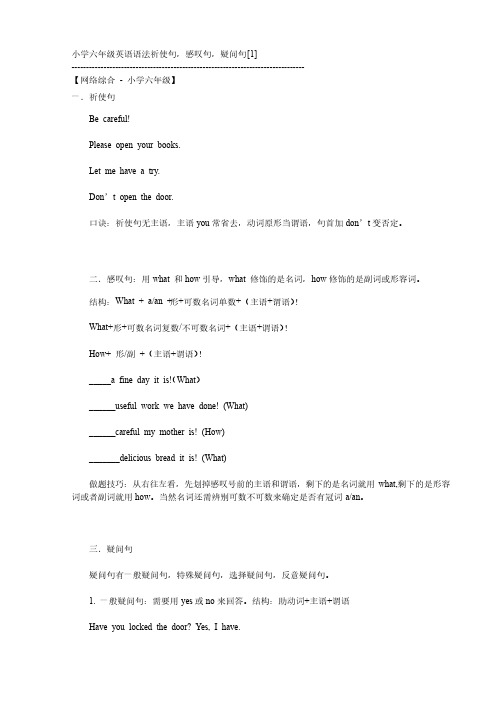
小学六年级英语语法祈使句,感叹句,疑问句[1] -------------------------------------------------------------------------------- 【网络综合【网络综合 - 小学六年级】小学六年级】一.祈使句一.祈使句Be careful! Please open your books. Let me have a try. Don ’t open the door. 口诀:祈使句无主语,主语you 常省去,动词原形当谓语,句首加don ’t 变否定。
变否定。
二.感叹句:用what 和how 引导,what 修饰的是名词,how 修饰的是副词或形容词。
修饰的是副词或形容词。
结构:What + a/an + 形+可数名词单数+(主语+谓语)!What+形+可数名词复数/不可数名词+(主语+谓语)!How+ 形/副 +(主语+谓语)!_____a fine day it is! (What )______useful work we have done! (What) ______careful my mother is! (How) _______delicious bread it is! (What) 做题技巧:从右往左看,先划掉感叹号前的主语和谓语,剩下的是名词就用what,剩下的是形容词或者副词就用how 。
当然名词还需辨别可数不可数来确定是否有冠词a/an 。
三.疑问句三.疑问句疑问句有一般疑问句,特殊疑问句,选择疑问句,反意疑问句。
疑问句有一般疑问句,特殊疑问句,选择疑问句,反意疑问句。
1. 一般疑问句:需要用yes 或no 来回答。
结构:助动词+主语+谓语谓语Have you locked the door? Yes, I have. Can you play the piano? Yes, I can. 2. 特殊疑问句:对句子中某一特殊部分提问的疑问句。
外研社(三起)小学英语六年级下册祈使句与感叹句

Exercise: 将下列陈述句转换为感叹句。
1. She swims wonderfully. 2. It is an interesting book. 3. They are cute pencil boxes. 4. The sunglasses are cool. 5. Her hair is short.
what感叹句结构: 1.What+a/an+形容词+名词(+主语+谓语)! 2.What+形容词+名词复数(+主语+谓语)!
例: What an interesting story (it is)! What beautiful flowers (they are)!
how感叹句结构: 1.How +形容词/副词+主语+谓语!
祈使句的否定式
在祈使句的肯定式中,谓语动词用don't/never+原形。 Don't worry. Never mind. Don't turn off the light! Don't play football on the road!
祈使句的否定式练习
将下列祈使句变为否定句。 1.Give me some apples. 2.Let's clean the classroom. 3.Be quiet. 4.Please watch TV. 5.Run around the playground.
祈使句的let式
Let + 人称代词(宾格)+动词原形
Let me see. Let me check. Let's go to the seaside. Let's go home.
小学英语语法-祈使句
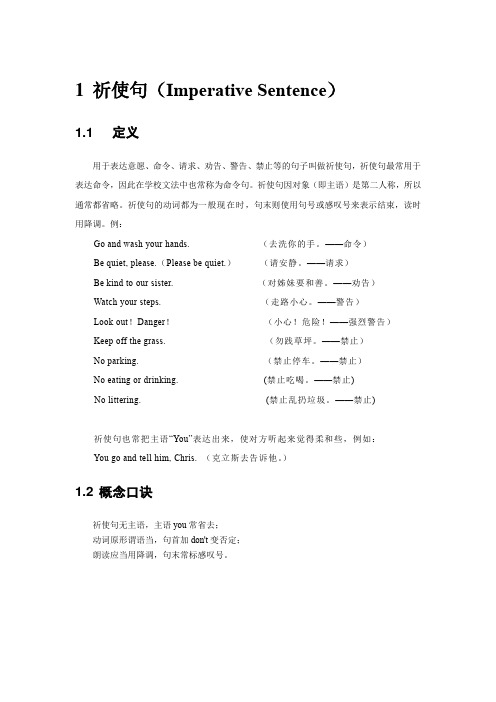
1祈使句(Imperative Sentence)1.1 定义用于表达意愿、命令、请求、劝告、警告、禁止等的句子叫做祈使句,祈使句最常用于表达命令,因此在学校文法中也常称为命令句。
祈使句因对象(即主语)是第二人称,所以通常都省略。
祈使句的动词都为一般现在时,句末则使用句号或感叹号来表示结束,读时用降调。
例:Go and wash your hands. (去洗你的手。
——命令)Be quiet, please.(Please be quiet.)(请安静。
——请求)Be kind to our sister. (对姊妹要和善。
——劝告)Watch your steps. (走路小心。
——警告)Look out!Danger!(小心!危险!——强烈警告)Keep off the grass. (勿践草坪。
——禁止)No parking. (禁止停车。
——禁止)No eating or drinking. (禁止吃喝。
——禁止)No littering. (禁止乱扔垃圾。
——禁止)祈使句也常把主语“You”表达出来,使对方听起来觉得柔和些,例如:You go and tell him, Chris. (克立斯去告诉他。
)1.2 概念口诀祈使句无主语,主语you常省去;动词原形谓语当,句首加don't变否定;朗读应当用降调,句末常标感叹号。
1.3 表现形式1.3.1肯定句1.Do型(即:动词原形(+宾语)+其它成分)。
如:Please have a seat here. 请这边坐。
有的祈使句在意思明确的情况下,动词可省略。
如:This way, please. = Go this way, please. 请这边走。
2.Be型(即:Be + 表语(名词或形容词)+其它成分)。
如:Be a good boy! 要做一个好孩子!3.Let型(即:Let + 宾语+ 动词原形+ 其它成分)。
如:Let me help you. 让我来帮你。
五个祈使句的句子英语六年级上册
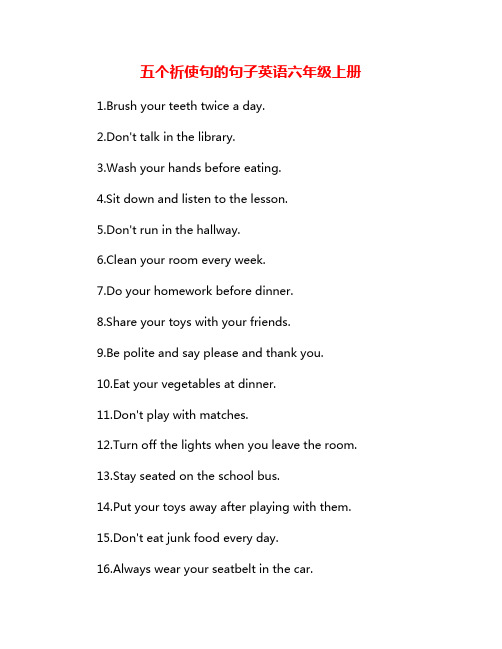
五个祈使句的句子英语六年级上册1.Brush your teeth twice a day.2.Don't talk in the library.3.Wash your hands before eating.4.Sit down and listen to the lesson.5.Don't run in the hallway.6.Clean your room every week.7.Do your homework before dinner.8.Share your toys with your friends.9.Be polite and say please and thank you.10.Eat your vegetables at dinner.11.Don't play with matches.12.Turn off the lights when you leave the room.13.Stay seated on the school bus.14.Put your toys away after playing with them.15.Don't eat junk food every day.16.Always wear your seatbelt in the car.17.Follow the rules in the classroom.18.Don't feed the animals at the zoo.19.Keep your hands to yourself.20.Be kind to others and help those in need.21.Brush your teeth after every meal.22.Always listen to your teacher in class.23.Don't forget to bring your textbooks to school.24.Respect your parents and elders.25.Help your classmates when they need assistance.26.Clean your room before going to bed.27.Be kind to animals and treat them with care.28.Don't talk while the teacher is speaking.29.Finish your homework before playing video games.30.Eat your vegetables to stay healthy.31.Remember to say please and thank you.32.Share your toys with your siblings.33.Put away your belongings after using them.34.Stay seated during class unless told otherwise.35.Get up early for school every morning.36.Wash your hands before eating a meal.37.Dress warmly in the winter to avoid getting sick.38.Take care of your personal hygiene.39.Don't run in the hallways of the school.40.Be polite and use good manners with everyone you meet.41.Brush your teeth before going to bed.42.Clean your room every Saturday.43.Do your homework carefully.44.Turn off the lights when you leave the room.45.Play outside with your friends.46.Listen to the teacher during class.47.Eat your vegetables for a healthy diet.48.Say thank you to show appreciation.49.Be kind to your classmates.50.Share your toys with your siblings.51.Wash your hands before meals.e kind words when speaking to others.53.Help your parents with household chores.54.Follow the rules in school.55.Be polite to elders.56.Take care of your belongings.57.Respect other people's opinions.58.Exercise regularly to stay healthy.59.Study hard to achieve good grades.60.Be responsible for your actions.61.Brush your teeth before bedtime.62.Pay attention to the teacher in class.plete your homework on time.64.Clean your room every weekend.65.Eat breakfast before going to school.66.Share your toys with your friends.67.Say "please" and "thank you".68.Listen carefully to your parents.69.Be kind to animals.70.Help your classmates when they need it.71.Respect your elders.72.Practice good manners at the table.73.Follow safety rules in the playground.74.Avoid talking loudly in the library.75.Keep your hands to yourself.e indoor voices inside the school building.77.Play nicely with your siblings.78.Put your toys away after you're done playing.79.Pick up trash and throw it in the bin.80.Remember to say sorry when you make a mistake.81.Please close the window.82.Keep quiet in the library.83.Don't play with fire.84.Be careful when crossing the road.85.Listen carefully to the teacher.86.Clean your room before going out.87.Don't forget to brush your teeth.88.Help your classmates with their work.89.Read the instructions before starting.90.Write your name at the top of the paper.91.Always say please and thank you.92.Share your toys with your friends.93.Don't run in the hallway.94.Put your hand up to ask a question.95.Respect your elders.96.Take turns when playing games.97.Follow the rules of the game.98.Check your work for mistakes.99.Practice your math skills every day.100.Remember to say sorry when you make a mistake. 101.Clean your room.102.Brush your teeth after meals.103.Do your homework before playing games. 104.Listen carefully to the teacher in class. 105.Be kind to your classmates.106.Help your parents with household chores. 107.Respect your elders.108.Wash your hands before eating.109.Stay organized with your school materials. 110.Be on time to all your classes.111.Follow the rules on the playground. 112.Share your toys with your friends.e kind words when speaking to others. 114.Be thankful for what you have.115.Think before you speak.116.Take care of your belongings.117.Say please and thank you.118.Apologize when you make a mistake.119.Be honest with others. 120.Always try your best.。
- 1、下载文档前请自行甄别文档内容的完整性,平台不提供额外的编辑、内容补充、找答案等附加服务。
- 2、"仅部分预览"的文档,不可在线预览部分如存在完整性等问题,可反馈申请退款(可完整预览的文档不适用该条件!)。
- 3、如文档侵犯您的权益,请联系客服反馈,我们会尽快为您处理(人工客服工作时间:9:00-18:30)。
小学六年级英语语法祈使句,感叹句,疑问句[1]
--------------------------------------------------------------------------------
【网络综合- 小学六年级】
一.祈使句
Be careful!
Please open your books.
Let me have a try.
Don’t open the door.
口诀:祈使句无主语,主语you常省去,动词原形当谓语,句首加don’t变否定。
二.感叹句:用what 和how引导,what 修饰的是名词,how修饰的是副词或形容词。
结构:What + a/an + 形+可数名词单数+(主语+谓语)!
What+形+可数名词复数/不可数名词+(主语+谓语)!
How+ 形/副+(主语+谓语)!
_____a fine day it is! (What)
______useful work we have done! (What)
______careful my mother is! (How)
_______delicious bread it is! (What)
做题技巧:从右往左看,先划掉感叹号前的主语和谓语,剩下的是名词就用what,剩下的是形容词或者副词就用how。
当然名词还需辨别可数不可数来确定是否有冠词a/an。
三.疑问句
疑问句有一般疑问句,特殊疑问句,选择疑问句,反意疑问句。
1. 一般疑问句:需要用yes或no来回答。
结构:助动词+主语+谓语
Have you locked the door? Yes, I have.
Can you play the piano? Yes, I can.
2. 特殊疑问句:对句子中某一特殊部分提问的疑问句。
结构:特殊疑问词+ 一般疑问句
特殊疑问词:“非常6+1”,即6个W开头的疑问词(what/who/which/where/when/why)和1个H(How)开头的疑问词。
★how 与what的其他用法
⑴How much money do you want?
How many pictures did you buy?
How fast does he drive?
How often do you go abroad?
How many times do you go swimming in summer?
How soon will you come back?
How long have you been here?
(2)What number are you?
What color is your coat?
What time is it?
What day is it today?
3. 选择疑问句:提供两种或两种以上的情况,供对方选择的。
选择疑问句不能用Yes和No回答,其答案只能是问句中提到的两个选择之一,如果考试中出现选择疑问句的选择题,选项中的Yes 和No都要排除.
Do you like tea or coffee?I like coffee.
Do you speak English or French? I speak English
Who runs faster, Tom or John? Tom.
小学六年级英语作文.
2008-3-12 23:26
提问者:yylin1221|浏览次数:2494次
1.写一篇题目为<My home>的英语作文.
2.写一篇题目为<My garden>的英语作文.
My home
This is my home
There are many things in my home
There are some windows in the home
There are two tables and a desk in the home
There are many chair in the home
My home is very big
My garden
This is my garden
There are many grass in the garden
There are some trees in the garden
There are many flowers on the trees
There are some birds in the trees
My garden is so nice
小学二(2)班班规
一、安全方面
1、每天课间不能追逐打闹。
2、中午和下午放学要结伴回家。
3、公路上走路要沿右边走,过马路要注意交通安全。
4、不能在上学路上玩耍、逗留。
二、学习方面
1、每天到校后,不允许在走廊玩耍打闹,要进教室读书。
2、每节课铃声一响,要快速坐好,安静地等老师来上课。
3、课堂上不做小动作,不与同桌说悄悄话,认真思考,积极回答问题。
4、养成学前预习、学后复习的好习惯。
每天按时完成作业,保证字迹工整,卷面整洁。
5、考试时做到认真审题,不交头接耳,不抄袭,独立完成答卷。
三、升旗排队和两操方面
1、升旗时,要快速出教室排好队,做到快、静、齐,安静整齐地排队走出课室门,班长负责监督。
2、上午第二节后,快速坐好,按要求做好眼保健操。
3、下午预备铃声一响,在座位上做眼保健操。
四、卫生方面
1、每组值日生早晨7:35到校做值日。
2、要求各负其责,打扫要迅速彻底,打扫完毕劳动工具要摆放整齐。
3、卫生监督员(剑锋,锶妍,炜薪)要按时到岗,除负责自己的值日工作外,还要做好记录。
五、一日常规
1、每天学生到齐后,班长要检查红领巾。
2、劳动委员组织检查卫生。
3、每天负责领读的学生要督促学生学习。
4、上课前需唱一首歌,由文娱委员负责。
5、做好两操。
6、放学后,先做作业,然后帮助家长至少做一件家务事。
7、如果有人违反班规,要到老师处说明原因。
班训:
坐如钟站如松快如风静无声
班规:
课堂听讲坐如钟,精神集中认真听;
排队升旗站如松,做操到位展雄风;做事迅速快如风,样样事情记得清;自习课上静无声,踏实学习不放松;个人努力进步快,团结向上集体荣;我为领巾添光彩,标兵集体记我功。
扣分标准
注:每人基本分60分起,学期末核算总分,作为学期评先依据。
